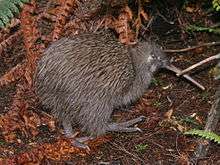New Zealand storm petrel
| New Zealand storm petrel | |
|---|---|
 | |
| Scientific classification | |
| Kingdom: | Animalia |
| Phylum: | Chordata |
| Class: | Aves |
| Order: | Procellariiformes |
| Family: | Hydrobatidae |
| Subfamily: | Oceanitinae |
| Genus: | Fregetta |
| Species: | Fregetta maoriana |
| Binomial name | |
| Fregetta maoriana (Mathews, 1912) | |
| Synonyms | |
|
Oceanites maorianus | |
The New Zealand storm petrel (Fregetta maoriana) is a small seabird of the tubenose family. Thought to be extinct since 1850, a series of sightings from 2003 to the present indicate the presence of a previously unknown colony.[1][2] As of 2010 it is ranked on the IUCN Red List as critically endangered.[3]
Description
The New Zealand storm petrel is a small seabird, dark brown/black above, except for its white rump. The underparts are black from the throat to the breast, with a white belly that has black streaking, and the feet project well beyond the tail. This storm petrel is strictly nocturnal at the breeding sites to avoid predation by gulls and skuas. Like most petrels, its walking ability is limited to a short shuffle to the burrow. It differs from the more common petrel species found in New Zealand, Wilson's storm petrel (O. oceanicus), by its pale bar on the upper wing, white belly with streaking, narrow white panel on the underwings, longer legs, and dark webs to the feet. Outside the breeding season it is pelagic, remaining at sea, and this, together with its remote breeding sites, makes it a difficult bird to observe.
Taxonomy
It has on occasion been considered a subspecies or even variant of Wilson's storm petrel but is quite distinct. In 2011 DNA samples from museum specimens in England and France matched that of birds in the Hauraki Gulf.[4] The study also suggested the species is probably more closely related to storm petrels in the genus Fregetta than Oceanites.[5]
Rediscovery

It had been believed to be extinct, but on 25 January 2003 a possible sighting was made by Sav Saville, Brent Stephenson and others close to the Mercury Islands off the Coromandel Peninsula of New Zealand's North Island, leading to several inconclusive photographs and an article being published. On 17 November 2003 while looking for black-bellied storm petrels and white-faced storm petrels, Bob Flood and Bryan Thomas obtained good photographs and video of 10 to 20 New Zealand storm petrels off Great Barrier and Little Barrier Islands in the Hauraki Gulf.[6] Subsequently, four storm petrels were captured and released in a similar area in late 2005/early 2006, three with radio transmitters attached. Tour operators have also regularly seen these birds on the Hauraki Gulf since this time.
The tagged birds were initially only tracked at sea; efforts to find the bird's breeding location were unsuccessful until 2013 when a breeding site on Little Barrier Island was found.[7] A team of researchers from Auckland University led by Chris Gaskin and Matt Rayner discovered the breeding site in the Hauraki Gulf Marine Park in February 2013. Researchers will continue observing the birds from a distance to prevent disturbing the breeding cycle. They hope to establish the distribution and population of the remaining New Zealand storm petrels.[8] In February 2014, the first ever egg of the New Zealand storm petrel on Little Barrier Island was discovered. It measured 31 mm by 23 mm and was coloured white with a fine dusting of pink spots concentrated at one end.[9]
References
- ↑ Flood (2003). "The New Zealand storm-petrel is not extinct. it was last seen in 2003". Birding world. 16: 479–483.
- ↑ "NZ seabird returns 150 years on". BBC News. 24 December 2003.
- ↑ "Oceanites maorianus". IUCN Red List of Threatened Species. Version 2011.1. International Union for Conservation of Nature. 2010. Retrieved 25 September 2011.
- ↑ Woulfe, Catherine (2011-09-25). "Big flap over little dead bird". Stuff.co.nz. New Zealand. Retrieved 2011-09-25.
- ↑ Robertson, Bruce; Brent M. Stephenson; Sharyn J. Goldstien (2011). "When rediscovery is not enough: Taxonomic uncertainty hinders conservation of a critically endangered bird". Molecular Phylogenetics and Evolution. doi:10.1016/j.ympev.2011.08.001.
- ↑ "The New Zealand Storm-petrel is not Extinct", Wrybill Birding
- ↑ "New Zealand Storm-petrel discovered breeding 50 km from Auckland City". BirdLife International. 25 February 2013. Retrieved 26 February 2013.
- ↑ Mason, Cassandra (February 25, 2013). "Critically endangered NZ storm petrel found breeding". New Zealand Herald. Retrieved 1 March 2013.
- ↑ "First NZ storm petrel egg found by scientists". New Zealand Herald. February 25, 2013. Retrieved 1 March 2014.
Further reading
- Gaskin, C.P.; Baird, K.A. (2005). "Observations of black and white storm petrels in the Hauraki Gulf, November 2003 to June 2005; Were they of New Zealand storm petrels?". Notornis. 52: 181–194.
- Saville, S.; Stephenson, B.; Southey, I. (2003). "A possible sighting of an 'extinct' bird – the New Zealand storm petrel". Birding World. 16: 173–175.
- Woulfe, Catherine (25 September 2011). "The Jesus bird returns". Sunday Star Times.
External links
- Species factsheet - BirdLife International

